Giant covalent - Study guides, Revision notes & Summaries
Looking for the best study guides, study notes and summaries about Giant covalent? On this page you'll find 176 study documents about Giant covalent.
All 176 results
Sort by
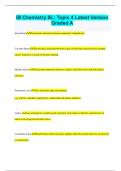
-
IB Chemistry SL: Topic 4 Latest Version Graded A
- Exam (elaborations) • 30 pages • 2024
- Available in package deal
-
- £8.26
- + learn more
IB Chemistry SL: Topic 4 Latest Version Graded A Ionic Bond Electrostatic attraction between oppositely charged ions Covalent Bond Electrostatic attraction between a pair of electrons and positively charged nuclei, formed as a result of electron sharing Metallic Bond Electrostatic attraction between a lattice of positive ions and delocalized electrons Polyatomic ions ions with more than one element e.g. CaCO3, Al(OH)3, Mg(NO3)2, (NH4)2SO4, Ba3PO4, LiHCO3 Lattice ions arran...
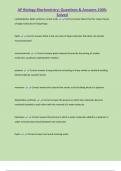
-
AP Biology Biochemistry; Questions & Answers 100% Solved
- Exam (elaborations) • 13 pages • 2024
- Available in package deal
-
- £10.23
- + learn more
AP Biology Biochemistry; Questions & Answers 100% Solved carbohydrates, lipids, proteins, nucleic acids Correct answer-Name the four major classes of large molecules in living things lipids Correct answer-What is the one class of large molecules that does not include macromolecules? macromolecule Correct answer-giant molecule formed by the joining of smaller molecules, usually by a dehydration reaction polymer Correct answer-a long molecule consisting of many similar or identical bu...
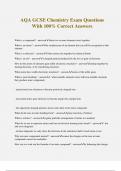
-
AQA GCSE Chemistry Exam Questions With 100% Correct Answers
- Exam (elaborations) • 17 pages • 2024
-
- £9.83
- + learn more
AQA GCSE Chemistry Exam Questions With 100% Correct Answers What is a compound? - answerwhen two or more elements react together What is an atoms? - answerthe smallest part of an element that can still be recognised as that element What is a molecule? - answerwhen atoms join together by chemical bonds What is an ion? - answera charged particle produced by the loss or gain of electrons How do the atoms of elements gain stable electronic structures? - answerjoining together by sharing elec...
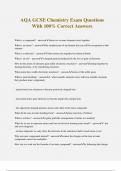
-
AQA GCSE Chemistry Exam Questions With 100% Correct Answers
- Exam (elaborations) • 17 pages • 2024
-
- £9.83
- + learn more
AQA GCSE Chemistry Exam Questions With 100% Correct Answers What is a compound? - answerwhen two or more elements react together What is an atoms? - answerthe smallest part of an element that can still be recognised as that element What is a molecule? - answerwhen atoms join together by chemical bonds What is an ion? - answera charged particle produced by the loss or gain of electrons How do the atoms of elements gain stable electronic structures? - answerjoining together by sharing elec...
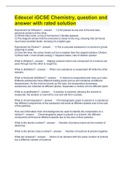
-
Edexcel iGCSE Chemistry, question and answer with rated solution
- Exam (elaborations) • 29 pages • 2023
- Available in package deal
-
- £16.13
- 1x sold
- + learn more
Edexcel iGCSE Chemistry, question and answer with rated solution Experiment for Diffusion? 1) HCl placed at one end of the test tube, ammonia solution at the other. 2) Where they meet, a ring of Ammonium Chloride appears. 3) The diagram shows that the ammonia is closer to the ring, showing that ammonia must have travelled faster, showing it's a lighter gas. Experiment for Dilution? 1) Put a coloured substance in a solvent e.g food colouring in water. 2) Over the time, the colour le...

-
WGU C785 unit 2 questions and answers already graded A+| Updated & Verified | 2024
- Exam (elaborations) • 12 pages • 2024
- Available in package deal
-
- £10.30
- + learn more
Hydrogen bond - Weak bond interaction Between two molecules amino group - Consists of hydorgen and nitrogen atoms (-NH3+) macromolecules - A giant molecule in a living organism formed by the joining of smaller molecules: a protein, carbohydrate, or nucleic acid. polymer - a long molecule consisting of many similar or identical building blocks linked by covalent bonds Amino acid - Amino group + Carboxylic acid + R group = Amino acid carboxyl group - A -COOH group, found in organic acids. ...
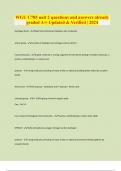
-
WGU C785 unit 2 questions and answers already graded A+| Updated & Verified | 2024
- Exam (elaborations) • 12 pages • 2024
-
- £10.61
- + learn more
Hydrogen bond - Weak bond interaction Between two molecules amino group - Consists of hydorgen and nitrogen atoms (-NH3+) macromolecules - A giant molecule in a living organism formed by the joining of smaller molecules: a protein, carbohydrate, or nucleic acid. polymer - a long molecule consisting of many similar or identical building blocks linked by covalent bonds Amino acid - Amino group + Carboxylic acid + R group = Amino acid carboxyl group - A -COOH group, found in organic acids. ...
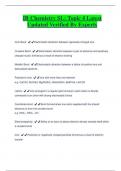
-
IB Chemistry SL: Topic 4 Latest Updated Verified By Experts
- Exam (elaborations) • 19 pages • 2024
- Available in package deal
-
- £14.16
- + learn more
IB Chemistry SL: Topic 4 Latest Updated Verified By Experts Ionic Bond ️️Electrostatic attraction between oppositely charged ions Covalent Bond ️️Electrostatic attraction between a pair of electrons and positively charged nuclei, formed as a result of electron sharing Metallic Bond ️️Electrostatic attraction between a lattice of positive ions and delocalized electrons Polyatomic ions ️️ions with more than one element e.g. CaCO3, Al(OH)3, Mg(NO3)2, (NH4)2SO4, Ba3PO4, Li...
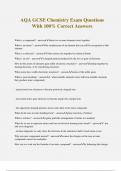
-
AQA GCSE Chemistry Exam Questions With 100% Correct Answers
- Exam (elaborations) • 17 pages • 2024
-
- £9.83
- + learn more
AQA GCSE Chemistry Exam Questions With 100% Correct Answers What is a compound? - answerwhen two or more elements react together What is an atoms? - answerthe smallest part of an element that can still be recognised as that element What is a molecule? - answerwhen atoms join together by chemical bonds What is an ion? - answera charged particle produced by the loss or gain of electrons How do the atoms of elements gain stable electronic structures? - answerjoining together by sharing elec...
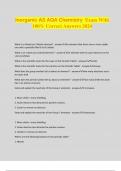
-
Inorganic AS AQA Chemistry Exam With 100% Correct Answers 2024
- Exam (elaborations) • 15 pages • 2024
- Available in package deal
-
- £9.83
- + learn more
Inorganic AS AQA Chemistry Exam With 100% Correct Answers 2024 What is a d-block (or f-block) element? - answerAn element that forms one or more stable ions with a partially filled d (or f) orbital What is an s-block (or p-block) element? - answerAn element with its outer electrons in the s (or p) orbitals What is the scientific name for the rows on the Periodic Table? - answerPeriods What is the scientific name for the columns on the Periodic Table? - answerGroups What does the group nu...

£5.50 for your revision notes multiplied by 100 fellow students... Do the math: that's a lot of money! Don't be a thief of your own wallet and start uploading yours now. Discover all about earning on Stuvia


